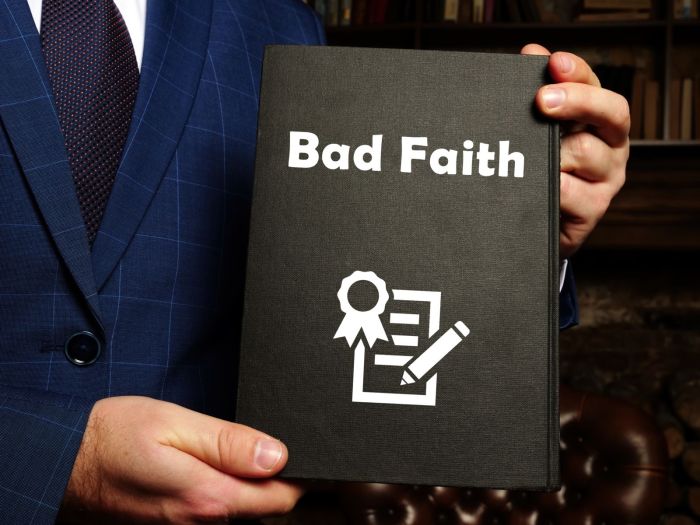The insurance industry, while designed to provide security, can sometimes become a battleground. When insurers deny legitimate claims or engage in unfair practices, policyholders find themselves facing a formidable opponent. This is where the expertise of a bad faith insurance attorney becomes invaluable. These legal professionals specialize in navigating the intricate legal landscape of insurance disputes, advocating for the rights of those wronged by their insurers.
This exploration delves into the multifaceted world of bad faith insurance claims, examining the legal definitions, common tactics, and strategies employed by both insurers and their legal representatives. We will explore the crucial role of the bad faith insurance attorney in securing justice for policyholders who have been unfairly treated, detailing the process of filing a claim, gathering evidence, and pursuing damages. We’ll also consider the ethical obligations of these attorneys and analyze impactful case studies to illuminate the complexities of this area of law.
Defining “Bad Faith” in Insurance Law

Insurance bad faith refers to an insurance company’s unreasonable and unfair denial of a legitimate claim, or its unreasonable delay or failure to properly investigate a claim. This conduct violates the implied covenant of good faith and fair dealing inherent in the insurance contract. Essentially, it’s a breach of the trust and fair dealing expected between an insurer and its policyholder.
The Legal Definition of Bad Faith
The precise legal definition of bad faith varies slightly from state to state, but generally involves a showing that the insurer acted without a reasonable basis for its actions and that it knew or should have known that its actions were unreasonable. This often requires demonstrating that the insurer’s conduct was intentional or reckless, not merely negligent. Proof typically involves evidence of the insurer’s internal processes, communications, and the overall handling of the claim. The burden of proof rests on the policyholder to demonstrate bad faith.
Common Examples of Insurer Bad Faith Practices
Several actions by insurance companies can constitute bad faith. These include: unreasonably delaying the investigation or processing of a claim; failing to adequately investigate a claim; denying a claim without a reasonable basis; failing to communicate with the insured; intentionally misrepresenting facts; pressuring the insured to accept a settlement that is significantly below the value of the claim; and using unfair claim practices such as requiring excessive documentation or employing aggressive tactics to discourage legitimate claims.
Comparison of Bad Faith Laws Across Different States
State laws governing insurance bad faith vary considerably. Some states have statutes specifically defining bad faith and outlining the remedies available to policyholders. Others rely primarily on common law principles. The availability of punitive damages, for example, differs significantly. Some states allow punitive damages to punish egregious bad faith conduct, while others limit their availability. The specific elements a policyholder must prove to establish bad faith also vary, as do the standards of review applied by courts. For instance, some jurisdictions might apply a stricter standard of review than others, making it more difficult for policyholders to succeed in bad faith claims. This necessitates a state-specific analysis when considering a bad faith claim.
Hypothetical Scenario Illustrating Bad Faith Behavior
Imagine Sarah, whose home is severely damaged by a fire. She files a claim with her homeowner’s insurance company, “Reliable Insurance.” Reliable Insurance assigns an adjuster who conducts a cursory inspection, fails to adequately document the damage, and undervalues the claim significantly. Despite Sarah providing extensive documentation, including photos and contractor estimates, Reliable Insurance denies her claim citing insufficient evidence. Further investigation reveals Reliable Insurance’s adjuster had a history of undervaluing claims to meet internal performance goals, a fact that was not disclosed to Sarah. Reliable Insurance’s actions, including the inadequate investigation, undervaluation, and the failure to communicate transparently, could constitute bad faith. This scenario highlights how an insurer’s internal practices and motivations can be critical evidence in a bad faith claim.
Evidence and Proof in Bad Faith Cases

Proving bad faith in an insurance claim requires a strong evidentiary foundation. The plaintiff must demonstrate not only that the insurer acted unreasonably, but also that this unreasonable conduct caused them demonstrable harm. This involves presenting a compelling narrative supported by various types of evidence, carefully organized to build a persuasive case.
Types of Evidence in Bad Faith Lawsuits
Evidence presented in bad faith lawsuits is multifaceted and aims to paint a complete picture of the insurer’s actions and their impact on the insured. This evidence can include, but is not limited to, documentation from the claims process, witness testimony, expert opinions, and even the insurer’s internal communications. The specific evidence needed will vary depending on the circumstances of each case, but a comprehensive approach is generally crucial.
Demonstrating Damages Caused by Bad Faith
Damages resulting from an insurer’s bad faith actions can be significant and encompass various forms. These can include the actual financial losses suffered due to delayed or denied payments, such as medical expenses, lost wages, or property repair costs. Beyond financial losses, emotional distress, reputational harm, and punitive damages may also be recoverable depending on the jurisdiction and the severity of the insurer’s misconduct. For instance, a delay in paying medical bills that leads to a decline in the insured’s health, requiring more extensive and costly treatment later, can be used to demonstrate significant damages. Similarly, an insurer’s refusal to cover a legitimate claim can cause significant financial strain and emotional distress, impacting the insured’s credit rating and mental well-being.
Organizing Evidence for a Bad Faith Claim
A well-organized presentation of evidence is essential for success in a bad faith lawsuit. The evidence should be meticulously documented and presented in a logical sequence, demonstrating a clear timeline of events and the insurer’s actions. This often involves chronological presentation, starting with the initial claim and progressing through the investigation, denial, and any subsequent appeals. This structured approach allows the court to easily follow the progression of the case and assess the insurer’s conduct at each stage.
| Evidence Type | Description | Source | Relevance to Bad Faith Claim |
|---|---|---|---|
| Claims File Documentation | All correspondence, claim forms, investigation notes, and internal memos related to the claim. | Insurer’s records | Demonstrates the insurer’s handling of the claim, revealing potential delays, inadequate investigations, or unreasonable denials. |
| Witness Testimony | Statements from the insured, witnesses, and experts who can attest to the insurer’s actions and the impact on the insured. | Depositions, affidavits, trial testimony | Provides firsthand accounts of the insurer’s conduct and its consequences for the insured. |
| Expert Testimony | Opinions from experts in insurance law, claims handling, or relevant fields (e.g., medical, financial) to support the plaintiff’s claims. | Expert reports, depositions, trial testimony | Provides an objective assessment of the insurer’s conduct and the damages suffered by the insured. |
| Internal Insurer Communications | Emails, memos, and other internal communications that reveal the insurer’s true motives and decision-making processes. | Insurer’s records (through discovery) | Can expose bad faith actions that were concealed from the insured. |
| Financial Records | Bank statements, medical bills, lost wage statements, and other financial documentation demonstrating the insured’s damages. | Insured’s records | Quantifies the financial losses suffered by the insured as a direct result of the insurer’s bad faith actions. |
Ethical Considerations for Insurance Attorneys
Insurance attorneys representing insurers in bad faith cases navigate a complex ethical landscape. They are bound by professional responsibility rules that demand zealous advocacy for their clients while simultaneously upholding the integrity of the legal system and ensuring fair treatment of claimants. The inherent conflict between fiercely defending an insurer and ensuring ethical conduct presents unique challenges.
Ethical Obligations of Insurance Attorneys Representing Insurers
Attorneys representing insurers accused of bad faith have a duty to act with honesty and integrity. This encompasses a commitment to full disclosure of relevant facts, even those that might be detrimental to their client’s case. They must avoid misleading the court or opposing counsel, and must ensure that all legal arguments are supported by a reasonable basis in law and fact. Furthermore, they have a duty to advise their clients on the ethical implications of their actions and to discourage any conduct that could be considered bad faith. Failure to do so can lead to professional discipline. For example, an attorney who knowingly allows their client to withhold crucial evidence could face sanctions.
Consequences of Unethical Behavior by an Insurance Attorney
Unethical conduct by an insurance attorney can result in a range of serious consequences. These can include disciplinary actions from state bar associations, leading to suspension or disbarment. Such actions can permanently damage an attorney’s reputation and career. Furthermore, unethical behavior can lead to significant financial penalties for both the attorney and their client. In cases where unethical conduct contributes to a bad faith judgment, the attorney may be held personally liable for damages. For instance, a court might order the attorney to pay a portion of the punitive damages awarded to the claimant. The attorney’s malpractice insurance may not cover damages stemming from intentional misconduct.
Comparison of Ethical Standards for Insurance Attorneys and Other Legal Professionals
While the fundamental ethical rules applicable to all attorneys apply equally to those specializing in insurance law, there are nuances. The potential for conflicts of interest is heightened in insurance bad faith cases. For example, an attorney might face pressure to prioritize the insurer’s financial interests over the fair settlement of a claim. This requires a higher degree of self-awareness and ethical vigilance. The standards remain consistent in their core principles of honesty, integrity, and client confidentiality, but the practical application of these principles often presents unique challenges within the insurance context. The potential for financial incentives to prioritize insurer interests requires a higher level of ethical scrutiny.
Proposed Code of Conduct for Attorneys Handling Bad Faith Insurance Claims
A code of conduct specifically addressing ethical considerations for attorneys handling bad faith insurance claims should emphasize the following: A commitment to fair dealing with claimants, including prompt investigation of claims and good-faith attempts at settlement. Transparency in all communications with claimants and their counsel. Avoidance of tactics designed to delay or obstruct the claims process. A commitment to full disclosure of all relevant information to the court and opposing counsel. A requirement for attorneys to actively advise their clients on the ethical implications of their actions. Regular ethical review of cases by a supervisory attorney or ethics committee. A clear and accessible process for reporting ethical violations within the firm. This comprehensive approach would aim to foster a culture of ethical practice within the insurance defense bar and better protect the interests of all parties involved in insurance disputes.
Final Conclusion

Ultimately, understanding the nuances of bad faith insurance claims empowers policyholders to protect their rights and pursue just compensation when faced with unfair treatment. The role of the bad faith insurance attorney is critical in this process, providing essential legal guidance and advocacy. By understanding the legal framework, common practices, and ethical considerations, both policyholders and legal professionals can work towards a more equitable insurance system. The information provided here serves as a foundation for navigating this complex area, but seeking professional legal counsel is always recommended when dealing with a bad faith insurance claim.
User Queries
What constitutes sufficient evidence to prove bad faith?
Sufficient evidence varies by jurisdiction, but generally includes documentation showing unreasonable delays, denial of coverage without proper investigation, or intentional misrepresentation of policy terms.
How long does a bad faith lawsuit typically take?
The duration varies significantly based on case complexity, jurisdiction, and discovery processes. It can range from several months to several years.
What are the potential consequences for an insurance company found guilty of bad faith?
Consequences can include significant monetary damages (compensatory and punitive), legal fees for the policyholder, reputational harm, and potential regulatory sanctions.
Can I represent myself in a bad faith lawsuit?
While you can, it’s strongly discouraged. Insurance companies employ experienced legal teams. A bad faith attorney provides crucial expertise in navigating complex legal procedures and building a strong case.